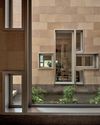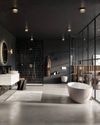Inspired by the organic shapes found in the Negev desert, Israel’s Ramon International Airport is a futuristic mirage in an ancient place of passage.

From the air, this new airport in southern Israel looks like a mirage in the middle of the austere Negev desert.
Craggy sandstone mountains tower in the distance, as the vivid white roofs of the terminal buildings reflect light like a body of water and the gently meandering lanes of the parking lot mimic the curves of the existing river delta.
Completed this year, the Ilan and Asaf Ramon International Airport is a 1,250-acre greenfield project.
Replacing the decommissioned Eilat Airport, the airport has a 3.6km runway and is expected to handle 4.25 million domestic and international passengers annually.
The terminal’s futuristic façade is composed of tilted triangular panels and 3,200m2 of glass curtain walls, based on a minimalist design concept of carved geometries.
“Our chief inspiration was the ever-developing world of aviation within the context and timelessness of the site’s desert location,” says design manager architect, Amir Mann.
“We didn’t try to compete with the overwhelming emptiness of the site, rather study its shapes and transform them into a language of design for an airport, minimal and unique – a seemingly futuristic mirage.”
Ramon Airport is located in Timna, 18km north of Eilat and the Red Sea in the southernmost tip of Israel, which has also strongly informed its design.
“This desert valley was a place of passage of the Hebrews from Ancient Egypt north to the land of Israel,” says Mann.
“One can imagine that during this journey, someone dreamed of flying like a bird. Presently the Ramon Airport allows the passage of individuals living thousands of kilometres away into this same ancient valley.”
Denne historien er fra Issue 111-utgaven av d+a.
Start din 7-dagers gratis prøveperiode på Magzter GOLD for å få tilgang til tusenvis av utvalgte premiumhistorier og 9000+ magasiner og aviser.
Allerede abonnent ? Logg på
Denne historien er fra Issue 111-utgaven av d+a.
Start din 7-dagers gratis prøveperiode på Magzter GOLD for å få tilgang til tusenvis av utvalgte premiumhistorier og 9000+ magasiner og aviser.
Allerede abonnent? Logg på

Home Is Where The Heart Is
A vacation house is reimagined for a multi-generational family to gather for holidays in the bucolic setting of Yongjia in Zhejiang, China.

the natural balance
Inspired by the serene beauty of dewdrops, the Antao Collection by Villeroy & Boch transforms bathrooms into wellness sanctuaries, combining sustainability with timeless elegance.

inspiring creativity and exploration
The new Hafary House at Lavender reflects the brand’s vibrancy and innovation, as well as provide an inspiring and engaging space for customers.

balancing act: nature and humanity
In this inspiration-led series, we asked Jay Liu and Alex Liu, co-founders of Right Angle Studio, to dream up a unique interior concept using mainly items from Space Furniture.

rethinking, remaking, reframing
Aoki Akio, the founder of DESIGNART TOKYO discusses the importance and legacy of Tokyo's eminent art and design event, particularly for young creatives.

rebuilding communities
Shift2024, the much-anticipated conference returns with a stellar line-up of prolific architects making their mark in Asian urban design.

unparalleled italian craftsmanship
Filippo Arnaboldi, Chief Executive Officer of Frette, tells us how this luxury lifestyle Italian brand is moving forward with times yet not forgetting about its existing legacy.

where the mountain meets the sea
This bespoke hillside residence features modern design elements, natural touches, and panoramic ocean views.

tailored for the curious explorer
The new Alma House at the New Bahru enclave reflects the collaborative spirit of a school environment.

tranquil sanctuary
The recently launched Banyan Tree Higashiyama Kyoto, designed by Kengo Kuma, fuses traditional Japanese architecture with modern elegance.